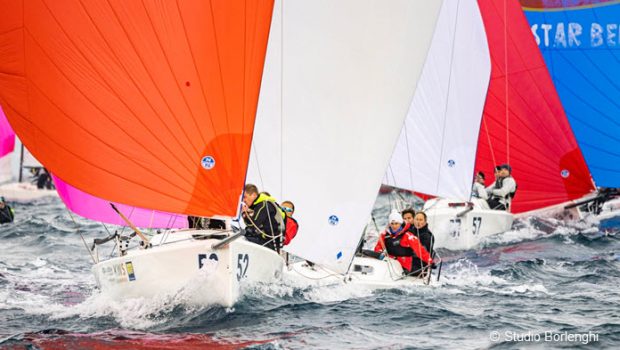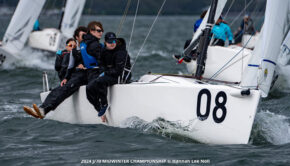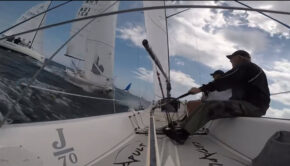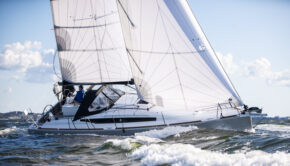Preparing for the World Championship
Published on April 6th, 2022
When the J/70 launched in 2012, J/Boats had envisioned a 23-footer that would offer a welcoming platform for Corinthian competition. It was a hit from the start, so much so that professional experts now had a flourishing class to earn a living, and their influence has increased the commitment needed to succeed.
When the 2022 J/70 World Championships are held October 14-22 in Monaco, it will attract not only the best sailors but also the keen eyes of coaches that will support their team. In this report, two North Sails J/70 experts share why they think this adds significant value:
North Sails expert Giulio Desiderato is a J/70 European champion, but for the first part of the 2022 season he has stepped away from the mainsail trimmer/ tactician role to coach Elvis—and says he’s learned a surprising amount.
“Off the boat, I can see the fleet from outside and also see the dynamics of the team. And every time, I find something that I want to try when I jump back on board. That’s not only interesting, and a great way to improve.”
Of course no coach can help sailors unless they really want to learn, he points out. “The Elvis guys are a Corinthian team, and they are really motivated to improve and become better overall sailors. As a coach, that definitely makes life easier when you can work with a team with this attitude, I’m sure that they will be on the top soon.”
Data Overload?
When he first started working with Elvis, Desiderato was concerned about overwhelming them with too much information. “What I tried to do is divide it up into different areas: the start, boat handling, boat speed, tactics, and communication. Then we tried to improve a little in each area every day.
“It’s been interesting, because compared to a professional team, they were very open to new ideas. We had to decide together: What’s the routine each day? What is the best approach to the starting line? How do we accelerate?”
Daily Routine
Desiderato says he keeps the mornings and evenings pretty much the same for both training and racing. “We have a short morning briefing, which includes a video that is similar to the day’s conditions. I have quite a lot of J/70 material in my database, so I can show a particular maneuver or technique based on the forecast. It’s always helpful to show a video, because it helps the team to visualize what they have to do on the water.”
On training days, Desiderato helps the team prioritize what to work on, striving for a mix of both boat speed lineups and practice races. He follows the teams closely, taking video and photos that will help him communicate what he sees to the team.
On race days, Desiderato can’t speak to his team once they leave the dock nor can he get too close during racing. “You cannot go in the middle of the fleet, so you have to find the right moment and the right angle to take a picture. It’s easier to take video at the start or at mark roundings, and then maybe downwind you can follow from the side and do some videos to understand if the technique is good or not.
“I think a good coach should also take video and pictures of the top boats, in order to copy them. You have to be curious, and think all the time as a sailor. I feel strongly about the regatta and it feels like I’m sailing with my guys too.”
After sailing, they sit down for a debrief right away, “to speak immediately about what was most important and show video. Afterward I work on the photos, which help me explain in more detail about the tuning and the trimming. Usually the next morning I send the best pictures to the team, and we might discuss them at the morning meeting, especially if the conditions will be similar.”
From the Sailor’s Perspective
Though his team on Good to Go used to send their coach home once racing started, North Sails expert Alex Curtiss says they have already locked in Mark Ivey for the entire Worlds—and for all of their lead up regattas. That’s because they’ve set the Monaco event as a top priority.
“Doug Rastello, the owner, really likes it there,” Curtiss says, adding that they raced there three times over the winter. “It’s a really dynamic place to sail, because it’s a microclimate between the mountains and the Med. And the chop is really big; the whole city is concrete, and there’s a long seawall.
“The waves come in and hit it, and then you get these crazy reverbs; sometimes you’ll be sailing upwind with five foot waves coming from astern! We’ve had to learn to set the boat up differently on each tack.”
Biggest Advantage?
Asked to choose the biggest single value of coaching, Curtiss says it would be optimizing sail shape. “That’s a big thing, especially in a place like Monaco. Just having that outside eye on guys that are faster than us; Mark will say, ‘Okay, they’re slightly flatter than you’ or ‘these guys are slightly fuller.’
“And a lot of times when we get off the water, he’s thinking about something he saw that was not even on our radar. I definitely think that if you’re a Corinthian team, and you’re looking to crack into that next group or get in the front of the pack, having a coach for a whole event is wildly helpful.”









 We’ll keep your information safe.
We’ll keep your information safe.